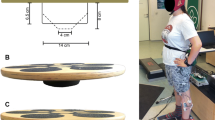Abstract
The present study examined, in children aged 4–11 and in adults, the postural control modifications when attention was oriented voluntary on postural sway. Since (1) there are less attentional resources in children than in adults, (2) the selective attention processing improves with age, i.e., children use a different strategy to focus their attention than adults, and (3) adults’ postural stability decreases when attention is focused on postural sway, we hypothesized that postural stability was less affected in children than in adults when attention was focused on postural sway. Fourty four children aged 4- to 11-year-old and 11 adults participated in the experiments. The postural control task was executed in a Romberg position. Two experimental conditions were presented to the subjects, (1) to look at a video on a TV screen without instruction about the posture, and (2) to fixate a cross placed at the center of the TV screen with the instruction to remain as stable as possible. Postural performance was measured by means of a force platform. Results from this study (1) confirmed a non-monotonic improvement of postural stability during the ontogenetic period without reaching the adults’ level at the age of 11, (2) suggested that children, aged 4–11, are able to focus their attention on the control of posture, and (3) showed that the automatic control of posture increases postural stability since the age of 4.


Similar content being viewed by others
References
Akhtar N, Enns JT (1989) Relations between covert orienting and filtering in the development of visual attention. J Exp Child Psychol 48:315–334
Assaiante C, Amblard B (1995) An ontogenetic model for the sensorimotor organisation of balance control in humans. Hum Mov Sci 14:13–43
Baumberger B, Isableu B, Fluckiger M (2004) The visual control of stability in children and adults: postural readjustments in a ground optical flow. Exp Brain Res 159:33–46
Belenkii VE, Gurfinkel VS, Paltsev EI (1967) On elements of control of voluntary movements. Biofizica 12:135–141
Blanchard Y, Carey S, Coffey J, Cohen A, Michlik S, Pellecchia GL (2005) The influence of concurrent cognitive tasks on postural sway in children. Pediatr Phys Ther 17:189–193
Enns JT, Brodeur DA (1989) A developmental study of covert orienting to peripheral visual cues. J Exp Child Psychol 48:171–189
Enns JT, Girgus JS (1984) Developmental changes in selective and integrative visual attention. J Exp Child Psychol 40:319–337
Figura F, Cama G, Capranica L, Guidetti L, Pulejo C (1991) Assessment of static balance in children. J Sports Med Phys Fitness 31:235–242
Hatzitaki V, Zisi V, Kollias I, Kioumourtzoglou E (2002) Perceptual-motor contributions to static and dynamic balance control in children. J Mot Behav 34:161–170
Hayes KC, Spencer JD, Riach CL, Lucy SD, Kirshen AJ (1985) Age related changes in postural sway. In: Winter D, Hayes K, Patla A (eds) Biomecanics IX-A. Human Kinetics Publishers, Champlain, pp 383–387
Kirshenbaum N, Riach CL, Starkes JL (2001) Non-linear development of postural control and strategy use in young children: a longitudinal study. Exp Brain Res 140:420–431
Lajoie Y, Teasdale N, Bard C, Fleury M (1996) Upright standing and gait: are there changes in attentional requirements related to normal aging? Exp Aging Res 22:185–198
Maki B, Holliday P, Fernie G (1990) Aging and postural control: a comparaison of spontaneous- and induced-way balance tests. J Am Geriatr Soc 38:1–9
Odendrick P, Sandstedt P (1984) Development of postural sway in the normal child. Hum Neurobiol 3:241–244
Olivier I, Cuisinier C, Vaugoyeau M, Nougier V, Assaiante C (2007) Dual-task study of cognitive and postural interference in 7-year-olds and adults. Neuroreport 18:817–821
Riach CL, Starkes JL (1994) Velocity of center of pressure excursions as an indicator of postural control systems in children. Gait Posture 2:167–172
Rival C, Ceyte H, Olivier I (2005) Developmental changes of static standing balance in children. Neurosci Lett 376:133–136
Shumway-Cook A, Woollacott MH (2000) Attentional demands and postural control: the effect of sensory context. J Gerontol Series A Biol Sci Med Sci 55:M10–M16
Slijper H, Latash ML, Mordkoff JT (2002) Anticipatory postural adjustments under simple and choice reaction time conditions. Brain Res 924:184–197
Slijper H, Latash ML (2004) The effects of muscle vibration on anticipatory postural adjustments. Brain Res 1015(1–2):57–72
Sundermier L, Woollacott M, Roncesvalles N, Jensen J (2001) The development of balance control in children: comparisons of EMG and kinetic variables and chronological and developmental groupings. Exp Brain Res 136:340–350
Teasdale N, Simoneau M (2001) Attentional demands for postural control: the effects of aging and sensory reintegration. Gait Posture 14:203–210
Vuillerme N, Nafati G (2007) How attentional focus on body sway affects postural control during quiet standing? Psychol Res 71(2):192–200
Vuillerme N, Nougier V (2004) Attentional demand for regulating postural sway: the effect of expertise in gymnastics. Brain Res Bull 63:161–165
Wickens CD (1974) Temporal limits of human information processing: a developmental study. Psychol Bull 81:739–755
Woollacott M, Debû B, Mowatt M (1987) Neuromuscular control of posture in the infant and child: is vision dominant? J Mot Behav 19:167–186
Woollacott MH, Shumway-Cook A (2002) Attention and the control of posture and gait: a review of an emerging area of research. Gait Posture 16:1–14
Wulf G, Prinz W (2001) Directing attention to movement effects enhances learning: a review. Psychon Bull Rev 8:648–660
Zachry T, Wulf G, Mercer J, Bezodis N (2005) Increased movement accuracy and reduced EMG activity as the result of adopting an external focus of attention. Brain Res Bull 67(4):304–309
Acknowledgements
Authors are grateful to the children and to their parents for their precious collaboration.
Author information
Authors and Affiliations
Corresponding author
Rights and permissions
About this article
Cite this article
Olivier, I., Palluel, E. & Nougier, V. Effects of attentional focus on postural sway in children and adults. Exp Brain Res 185, 341–345 (2008). https://doi.org/10.1007/s00221-008-1271-6
Received:
Accepted:
Published:
Issue Date:
DOI: https://doi.org/10.1007/s00221-008-1271-6




